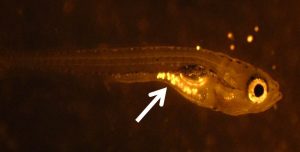
By
Christophe LeMoine, Bryan Cassone, Caleb Northam, Bailey Kelleher, Oluwadara Elebute, and Raphaël Lagarde
November 2018
Print Version
What you need to know
Microplastics are small plastic particles (less than 5mm) that can be purposely produced for consumer use (microbeads), or that result of the physical degradation of larger plastic debris. Although we have known about the presence of large plastic litter in our oceans for over four decades now, we are now finding microplastics in virtually every environment on our planet, making them an emerging environmental concern.
Why this research is important
Plastics are an integral part of our modern lives, and while they provide a convenient, inexpensive, and durable material from a consumer's perspective, these same characteristics make them problematic in terms of waste management. Indeed, every year we produce over 300 tons of plastic worldwide, with lots of it being readily disposable but hard to recycle or degrade. Thus, plastic accumulates in our landfills and eventually makes its way to our aquatic environment. While oceanic ‘plastic islands’ have been known for decades, more recently the plastic problem has been extended to our freshwater and terrestrial systems and more importantly has gone from the macroscopic (i.e., shopping bag), to the microscopic scale (micro- and nano-plastics). Moreover, the size of these microscopic particles makes them problematic from an environmental perspective as many different organisms may readily ingest them. However, despite the prevalence of microplastics worldwide we currently don't have a good handle on the repercussions of this contaminant on organisms, and therefore current research efforts aim at assessing the current and future risks associated with this pervasive pollutant.
How this research was conducted
To study microplastics, we selected a model species, the zebrafish, which lives in freshwater and is widely used as a biomedical model in laboratories around the world. We bred these fish and exposed their offspring to fluorescent polyethylene microplastics for a period up to two weeks. Throughout this exposure, we monitored larval fish growth, mortality, oxygen consumption and the accumulation of microplastics in their body. We also sampled some of the fish after two days and two weeks of exposure to assess if their overall gene expression profiles showed any effects resulting from contamination.
What the researchers found
Overall, we found little short-term physiological effects of the microplastics on zebrafish larvae. There was no detectable effect on the growth, survival rate or oxygen consumption of the fish exposed to these particles. We also noticed that throughout our experiment microplastics only accumulated in the intestine of the fish (see picture below) with no changes in how many particles accumulated over time. In contrast, we observed extensive changes in gene expression in fish exposed for two days that largely dissipated within two weeks of exposure. Notably, many of these broad changes affected genes involved with the nervous system, vision, and metabolism, all crucial pathways that could have broad repercussions later in the animal’s life.
How this research can be used
We now know that short-term exposure does not seem to affect many macroscopic physiological factors in these fish, however, in the real-world animals are exposed to these particles for a lifetime. Thus, using the same approach developed in this study, we can assess the impact of lifetime exposure to microplastics on long-term organismal health. Further, using our extensive genetic data, we can refine future studies and focus our work on examining specific factors (neural function, behavior, and metabolic health) in response to microplastics exposure.
Acknowledgements
We would like to thank the many sources of funding making this work possible, including BURC, NSERC Discovery grants, NSERC USRA, CFI, and the Company of Biologists.
About the Researchers
Keywords
- metabolism
- microplastics
- pollution
- toxicology
- zebrafish
Editor: Christiane Ramsey
Read more BU Research
Research at Brandon University follows comprehensive policies designed to safeguard ethics, to ensure academic integrity, to protect human and animal welfare and to prevent conflicts of interest.

